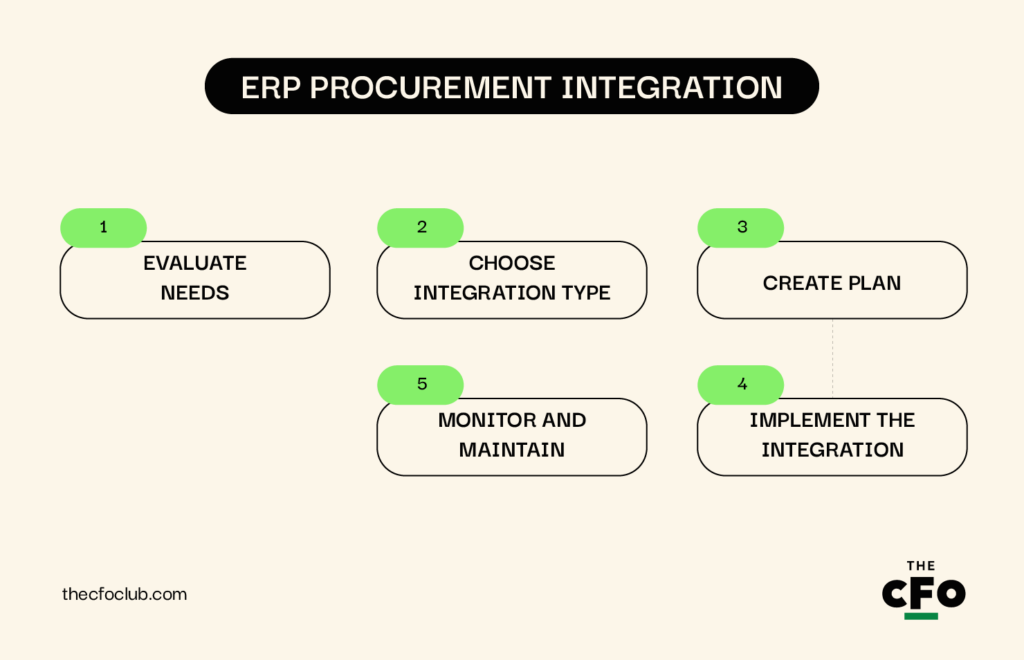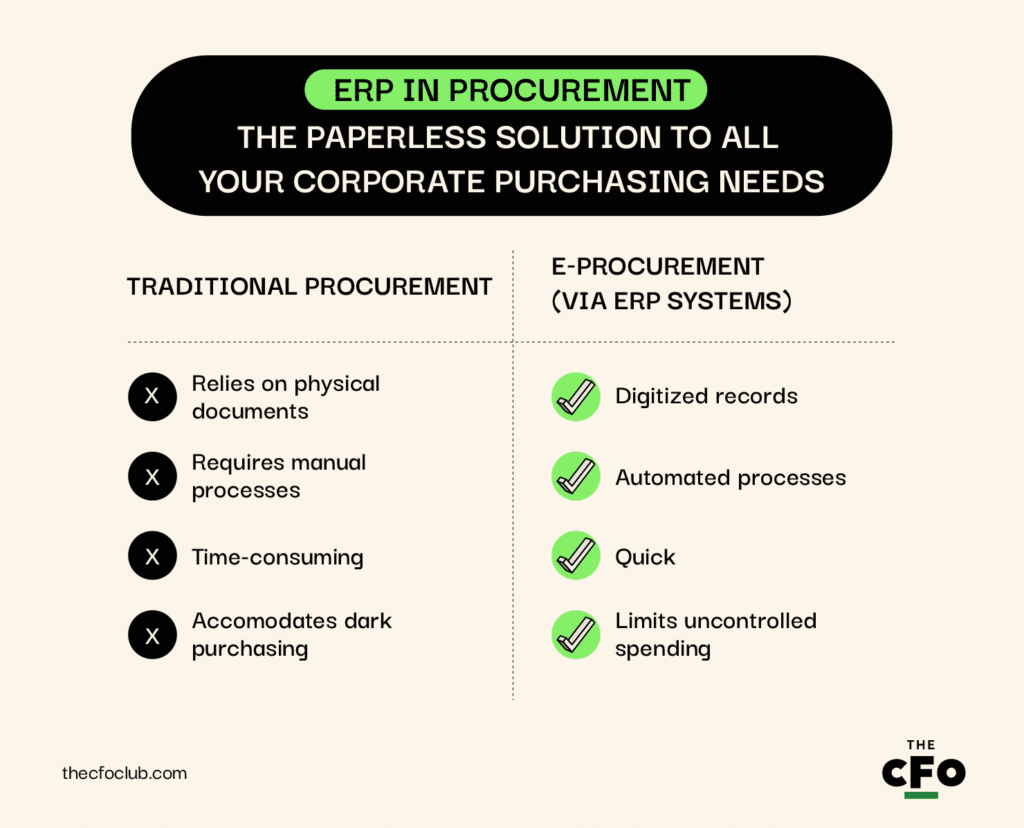Streamlining Corporate Buying: ERP procurement streamlines sourcing, vendor management, and purchase order processing, integrating these with other business functions.
Teamwork Makes the Dream Work: ERP systems foster inter-departmental collaboration by integrating various functions including finance, inventory, sales, and procurement.
Efficiency Unlocked: Key benefits include automating tasks, expediting procurement cycles, and allowing teams to focus on strategic activities like compliance and risk management.
I know it sounds like it, but no — ERP procurement is not the process of vetting and selecting suitable ERP software. Though, of course, that is important to successful implementation.
If you’re looking for help picking an ERP system, you’re talking to the right people. These are currently the best systems on the market:
ERP procurement involves using your chosen ERP software to automate and organize corporate procurement activities. Stick around, and I’ll show you how to ensure your system delivers the best ROI.
Introduction to ERP Procurement
ERP procurement (also called ERP in procurement) is the streamlining of procurement processes like sourcing, vendor management, and purchase order processing with an ERP solution.
Estimated to have brought in about $4.6 billion in 2021, the procurement software market has been growing steadily ever since, with SAP and Oracle leading the category.
For example, if you already use ERP software for human resources and finance management, it might have a procurement module you can also integrate. Or, if you have a procurement automation tool, it may contain an ERP integration, to connect your purchasing workflow with other business functions.
Ultimately, any enterprise resource planning procurement system will help you effectively manage budgets, track spending, and minimize costs.
Benefits of ERP in Procurement
Teamwork is key to business success, so company departments that work in silos are more likely to fail or move slowly. ERP systems integrate functions like finance, inventory management, sales, and (of course!) procurement, driving collaboration and business success.
Specifically, ERP software improves procurement processes by simplifying the buying of goods and services from different suppliers, maximizing resources and sustaining valuable vendor relationships.
Key benefits of ERP in procurement include:
1. Time and Cost Savings
ERP procurement systems automate routine tasks, speeding up the procurement cycle and enabling your team to focus on strategic activities like compliance and risk management.
By unifying procurement data and processes, ERP platforms also help you uncover cost-saving opportunities. For instance, if there’s an item you restock weekly, you can buy in bulk for wholesale discounts. Or, if you find that you only recoup purchase costs at the end of a quarter, you can attempt negotiating more flexible payment terms with suppliers.
The result? Significant time and cost savings.
2. Improved Spend Management
Procurement ERP systems provide real-time insights and spend analytics, enabling tighter accounting and budget control.
You’ll be able to follow spending patterns, identify inconsistencies, and manage resources better. This level of visibility helps you to make data-driven decisions, avoiding overspending and ensuring more efficient spend management.
3. Enhanced Supplier Relationship Management
Strong vendor relationships aid seamless procurement—and ERP systems help build them. They serve as centralized locations for supplier performance tracking, vendor management, and contract administration.
Having all this data in one place enhances collaboration and ensures prompt issue resolution, limiting how often suppliers fall short of delivery times and quality SLAs. It also enables improved negotiation outcomes and more reliable supply chains.
The likelihood is that [most companies] have very little opportunity to do vendor performance analysis. Combine this with the fact that the required information may be very difficult to obtain… ERP systems can not only gather and store this information but produce reports with a few simple clicks.
Challenges of ERP in Procurement
ERP systems offer tons of benefits, but they are not without their challenges and blind spots. By understanding them upfront, you have much better odds of side-stepping them.
The most common challenges of using ERP for procurement include process flexibility, collaboration issues, dark purchasing, change resistance, and customization limits. Here’s how:
Procurement Flexibility
Since ERP platforms are made to standardize operational processes, they can sometimes make adapting to unique business needs hard.
For example, you may need to update your purchasing process in response to supplier issues or market changes. Rigid ERP frameworks may not be agile enough, leading to delays and missed opportunities.
Fortunately, customizing workflows with an adaptable ERP software, updating processes regularly, and seeking bespoke solutions from the platform’s vendor can help tackle this issue.
Collaboration Issues
For procurement to be done efficiently, all stakeholders — from finance to production to inventory management — need to be on the same page and have access to information in real time.
However, an ERP system can sometimes create silos that lead to miscommunication, duplicated efforts, and inefficiencies, especially if the platform’s modules are not well integrated.
Enhance communication across departments by investing in smooth integrations between critical ERP modules. Also, plan frequent cross-functional meetings and training programs to boost collaboration and system understanding.
Dark Purchasing
Dark purchasing (also called maverick spending) is when team members make purchases outside established procurement processes. This deviation can cause budget overruns, strained vendor relationships, compliance issues, and a whole lot of headaches.
ERP systems can help prevent all these by enforcing procurement policies; though establishing to-the-dot, team-wide adherence is difficult and, sometimes, downright impossible.
Eliminate this risk by providing clear guidelines, establishing approval workflows, and conducting regular audits to expose recordless procurement.
Change Resistance
An ERP implementation typically comes with significant changes to your current workflows and processes, and employees who are used to the old ways of working may resist them.
This resistance can cause slower adoption rates and reduced effectiveness of the newly-configured ERP tool. Prevent these problems through careful change management, comprehensive employee training, and clear communication of benefits.
Involving employees during the implementation and testing process will also help buy their buy-in (pun intended) and reduce resistance.
Customization Limits
Off-the-shelf ERP systems may not fully match your business’s unique procurement processes, and customizing them can be complex, costly, or impractical. Also, extensive customization may cause more problems along the line.
Say you need to conduct routine maintenance checks or update the software. Automating these with a preconfigured program from the ERP system provider would be best, but add-on customizations may require extra manual input.
Prevent setbacks like this by selecting an ERP system that offers modular customization options and co-opting your ERP vendor to help with necessary aspects. Also, only implement essential customizations to avoid overcomplicating the system and future update incompatibility.
Key Features of ERP Procurement Modules
You’re ready to tap into the power of ERPs for procurement management. That’s great! But with so many potential systems, making a choice can feel overwhelming.
Save time and pick the best platform for your organization by checking for these top ERP procurement module features. While your preferred option may not offer every one of these solutions, it should meet your most critical requirements.
| Key ERP Procurement Module Features | |
| Purchase order (PO) management | Streamlines the creation, approval, and tracking of purchase requisitions and orders |
| Contract management | Manages vendor contracts and agreements for maximal compliance and visibility |
| Inventory and order management | Syncs procurement with inventory levels to prevent stockouts or overstocking |
| Sourcing | Identifies and assesses prospective suppliers for a diverse and reliable vendor base |
| Contingent workforce management | Monitors and optimizes the use of temporary or contract workers in line with procurement needs. |
| Supplier risk and performance management | Evaluates and tracks supplier performance and risks to maintain high standards |
| Spend analysis | Gives insights into procurement spending to uncover cost-saving opportunities and boost finances |
| Integrations | Enables tool stack connectivity via automatic data exchange |
1. Purchase Order (PO) Management
Every comprehensive ERP procurement module includes in-depth PO management capabilities. This feature enables PO creation, approval, and tracking, ensuring that you get items as needed and keep them well-documented.
2. Contract Management
Contract management involves effectively managing vendor agreements and monitoring contract status. The right ERP procurement module serves as a contract repository, ensuring all deal details are easily accessible, helping maintain compliance, and streamlining renewals.
3. Inventory and Order Management
Inventory and order management capabilities help you match procurement activities with stock levels and customer demand, preventing shortages or excess purchases. They also ensure seamless order tracking and delivery flow.
4. Sourcing
If you want to simplify and speed up your supplier vetting and selection process, an ERP procurement module with a strategic sourcing tool is best. This feature includes a vendor database where you can find and vet reliable suppliers, conserving resources and improving your output quality.
5. Contingent Workforce Management
This ERP procurement feature lets you effectively manage contract or temporary workers, aligning their employment with procurement needs and organizational goals. This helps you gain visibility and control over your contingent workers, leading to increased workforce quality, lower costs, and more efficient processes.
6. Supplier Risk and Performance Management
This feature is critical to successful ERP usage in procurement, as it helps assess and monitor potential risks associated with your suppliers.
Basically, good risk and performance management on suppliers equals fewer issues and high performance standards. Yes please!
7. Spend Analysis
The best ERP procurement modules have clear spend analysis functionalities that reveal procurement spending patterns. You can then use the uncovered insights to identify cost-saving opportunities, optimize procurement strategies, and improve overall financial performance.
8. Integrations
Finally, you want your ERP procurement modules to offer robust integration capabilities, enabling efficient business operations, and seamless connectivity with other enterprise processes and systems.
Let’s explore procurement ERP integrations in more detail.
Integration of Procurement Automation Software
Integrating your procurement automation software (or ERP module) with the rest of your business functions and tool stack is no small feat, but it’s 100% worth it.
So whether it’s syncing your procurement ERP to financial tools or connecting it to your team-wide identity provider, this guide will help you successfully connect procurement automation software with ERP systems.

1. Evaluate Your Integration Needs
Assess your current systems processes to identify the ones that need to communicate with your ERP procurement module, plus the data that needs to be exchanged.
Do this by first listing all the systems involved in procurement within your organization, like your CRM, accounting software, and inventory management app. Next, define the data flow between these systems and outline integration goals, like real-time data updates or batch processing.
2. Choose the Best Type of Integration
You can integrate your procurement automation software or ERP module to the rest of your business processes and tool stack in different ways. Choose the integration method that best matches your systems’ complexity and scalability needs.
For example, API-based integrations work well for instant data exchange between source and destination systems, like your CDP and CRM.
At the same time, middleware like enterprise service buses (ESBs) and iPaas tools are great for complex, multi-system environments and less complex, budget-friendly implementations, respectively.
3. Create an In-Depth Integration Plan
Depending on the complexity and scope of your operations, ERP procurement integration can take anything from a few minutes to several weeks.
A plan detailing the integration process, responsibilities, milestones, and timelines standardizes the project, keeping everything organized and efficient.
This step also requires you to:
- Map out data fields.
- Define workflows.
- Set up monitoring mechanisms.
This step is highly specific and dependent on your organization, so I recommend working with an internal project manager or external ERP consultant if you aren’t able to map the plan out on your own.
4. Implement the Integration
Integrate your relevant systems according to the set plan, but start with pilot ERP tests to ensure everything works as expected before complete rollout.
5. Monitor and Maintain the Integration
Once your ERP procurement integrations are live, make sure to track their performance and maintain the system for continued effectiveness.
Look out for arising issues like inconsistent data, system performance problems, and update requirements. Also, leverage monitoring automation tools, schedule regular maintenance checks, and collate end-user feedback to quickly uncover and mitigate roadblocks.
Industry Applications of ERP Procurement
ERP in procurement improves supplier management and supports various business functions, including manufacturing, retail, supply chain management, and logistics.
- Manufacturing: In the manufacturing industry, ERP procurement modules support the purchasing of raw materials and components, ensuring that production is not put on hold due to a lack of supplies.
- Retail: For retailers, procurement ERP systems help manage supplier relationships, negotiate better agreements, forecast demand, and make sure that stores have the right products at the right time.
- Supply Chain Management: ERP procurement modules facilitate supply chain management and ensure all components are available for production and distribution by coordinating purchasing activities across multiple vendors.
- Logistics: Procurement ERP software in logistics enables timely deliveries and minimal costs through efficient transportation and warehousing.
Future Trends in ERP Procurement
ERP procurement has promising prospects, with new technologies driving improved efficiency. Stay ahead of the pack by adapting to the demands of these critical future trends, ERP advancements, and procurement technology improvements:
→ Mobile ERP
Mobile ERP applications are gaining traction in procurement because they let users conveniently view and manage business purchases from anywhere.
This trend enables timely decision-making, better collaboration, and improved productivity for procurement professionals on the go.
→ Cloud-based ERP solutions
Cloud-based ERP solutions are getting more popular by the day, with the global cloud ERP market expected to hit a $40.5 billion valuation by 2025.
The reason they are so appealing to procurement teams is not far-fetched: While on-premise ERPs may offer greater security and control, cloud ERPs are more flexible, scalable, and cost-effective.
→ Internet of Things (IoT)
Integrating IoT devices into ERP systems enables real-time data collection and granular supply chain visibility. It’s no wonder vendors are incorporating the technology more and more. IoT data also enables informed decision-making, optimized inventory levels, and better supplier performance.
Linking IoT and transactional data is the gateway to digital transformation.
→ AI Systems Integration
Artificial intelligence is a trend that’s taken the tech sector by storm in the last few years, and the ERP niche was not left out.
AI is being increasingly integrated into ERP procurement systems to automate repetitive tasks, analyze large datasets, and predict demand — proactively mitigating supply chain risks.
Do It — Go Paperless
Traditional procurement relies on physical documents and requires a lot of manual processes that should be left in the past.
Moving forward, e-procurement via ERP systems are the way to go. They digitize purchasing records and automate supplier relations, making for a quicker, smoother, and more cost-effective procurement cycle.

Ready to compound your abilities as a finance professional? Subscribe to our free newsletter for expert advice, guides, and insights from finance leaders shaping the tech industry.



